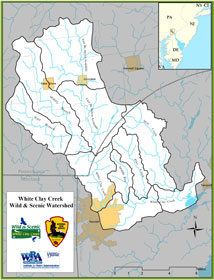
The University of Delaware’s Water Resources Agency in the Institute for Public Administration has played an active role in the designation and management of the White Clay Creek watershed for over two decades.
In October 2000 President Clinton signed the law designating 190 miles of the White Clay Creek and its tributaries into the National Wild and Scenic River System. The National Wild and Scenic River System, administered by the National Park Service, was created by an act of Congress in 1968. The White Clay Creek is the first wild and scenic river in the United States designated on a watershed basis rather than a river corridor.
The Wild and Scenic Rivers Act
|
The White Clay Creek watershed spans 107 sq. mi., approximately 55% lies in Pennsylvania and 45% lies in Delaware. The watershed is rich in natural, cultural, and historical resources that provide benefits to over 100,000 people. Proximity of the Philadelphia and Wilmington-Newark metropolitan areas, however, is having an impact on the watershed. Urbanization along with years of agriculture in the upper watershed has contributed to both states designating more than 75% of the stream miles as “impaired”. High nutrient (nitrate and phosphate), organic, sediment, and bacterial levels currently account for much of the water quality and stream habitat impairment.
White Clay Creek Wild and Scenic River Management Committee is composed of local citizens and representatives of conservation organizations, the States of Delaware and Pennsylvania, Chester and New Castle Counties, all 13 watershed municipalities, and the National Park Service. The National Park Service provides technical assistance and financial support, along with a national perspective. Together with respective partner organizations and governmental agencies, the committee works to implement the goals and objectives of the management plan. These include:
- Improve and conserve water quality and water quantity.
- Conserve open space, woodlands, wetlands, and geologic features.
- Monitor and protect native plant and animal species.
- Preserve cultural, historical, and archaeological sites.
- Enhance outdoor recreation opportunities.
- Encourage environmental education and watershed awareness.
IPA-WRA serves a variety of roles in the management of the Wild and Scenic White Clay Creek watershed and these include:
- Serving as Delaware cochair of the Executive Management Committee (Jerry Kauffman and Martha C. Narvaez)
- Providing assistance to the river administrator through the graduate research assistantship program.
- Developing and publishing reports related to the White Clay Creek watershed, for example, the White Clay Creek State of the Water Report, July 4, 2008.
- Participating and assisting with workshops and outreach activities.
For additional information go to www.whiteclay.org
